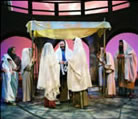Serving in the Jewish Temple
The most solemn part of the Jewish daily temple service was the incense offering, its rising smoke symbolizing Israel’s prayers. Priests in a state of ritual cleanliness and worthiness were selected by lot to perform the offering. Because of the great number of priests, the lot could fall to a priest only once in his lifetime, and many never enjoyed this privilege.1
Resurrection
Before the Resurrection of Christ, opinions were sharply divided concerning the meaning of resurrection. Many thought it was simply a metaphor for political, social, or spiritual renewal. Others believed that the dead would be raised literally but only at the end of the world. Even Jesus’ disciples found it difficult to conceive of the possibility that He would be resurrected. Before He was crucified, Jesus prepared them to understand that He would literally overcome death, and that they would indeed see Him again—and soon.2
Ancient Jewish Betrothal and Marriage Customs
In biblical Jewish culture, marriage was regarded as a sacred covenant symbolic of God’s relationship with His chosen people Israel. Parents were responsible for choosing appropriate spouses for their children, and the young man and woman were expected to accept their parents’ arrangements. Betrothal was similar to engagement as we now know it, but it was much more binding. Once betrothed a couple was considered legally married, even though the marriage was not yet consummated. Thus Luke refers to Mary as Joseph’s “espoused wife.”3 Betrothal was dissolved only under extreme circumstances, with severe consequences.4
Betrothal
The process of betrothal began when the prospective groom and his father or a close male relative (in the production Joseph’s uncle Micham) came to the bride’s house to meet with her father and determine the conditions of the marriage contract.5 Once the terms of the marriage were agreed upon, the groom could formally “propose” to his prospective bride. He would present her with a ketubah, a beautifully decorated formal document that specified the marriage terms and stated his intent to consecrate himself to his bride-to-be.6 The groom then offered her a gift of value, a possession symbolic of his esteem for her and his willingness to sacrifice in her behalf. Often this gift was a gold ring because the circle symbolized eternity.7
Then the groom made a ritual statement, such as the one found in Hosea 2:19–20, formally consecrating himself to his bride. The use of five virtues in this particular statement—“in righteous, in judgment, and in loving kindness, and in mercies, . . . in faithfulness”—symbolizes God and invites Him into the covenant being made.8
The groom then poured a cup of wine for the prospective bride. Because Jewish law stated that a woman could not be forced to marry a man distasteful to her, the bride was ultimately allowed to choose whether to accept or reject the groom’s proposal. If she drank the cup he offered, they were betrothed. The groom would formally accept his bride with another ritual statement, often “Thou art set apart (or consecrated) for me according to the law of Moses and Israel.” Interestingly, the same word for “set apart” was also used to describe a dedicated temple; the bride was considered a temple now set apart for her husband. From this point on, the bride would wear a veil over her hair in public to indicate her status as a betrothed or married woman.9
Building a Home
During the betrothal, the groom was exempt from obligations such as military service so he could fully devote himself to building a home for his bride and establishing a new household in Israel.10 This period often lasted from one to two years, and during this time the bride and groom did not visit each other. Only after the groom’s father had approved the new home and its workmanship could the groom return to claim his bride.
Swaddling Bands
While the groom built their new home, the bride also made preparations, including the embroidery of the swaddling bands with which the couple’s hands would be wrapped under the wedding canopy. Later these bands would also be used to secure blankets or swaddling clothes around the couple’s infant children. The symbols on the bands often indicated family history.11 Mary was from the tribe of Judah, so she may have used symbols common to that lineage such as a lion, a lamb, or a tree of life. As a descendant of David, she was also entitled to use the royal colors of blue and white. The symbolic significance of swaddling bands was so important that the embroidery on each side of the swaddling bands had to match exactly, with “right” and “wrong” sides indistinguishable. This symbolized the complete harmony of inner and outward life.12
Wedding
As the probable time of the wedding approached, the bride and her sisters, cousins, and friends would wait together each evening in anticipation of the groom’s arrival. It was customary for the groom to arrive suddenly, often late at night.13 The groom and his friends would carry the bride through the streets to her new home in a jubilant procession accompanied by music, torches, and well-wishers.14 At the wedding house, the bride and groom would each be dressed in white wedding garments, the color denoting purity.15 Then they would meet under the wedding canopy, which symbolized God’s presence blessing their union.
There are no complete descriptions of weddings in the Bible, but traditional sources indicate such elements as the wrapping of the couple’s hands in swaddling bands, sharing a goblet of wine symbolizing the sharing of their lives together, the reading of the ketubah or marriage contract, and the recitation of the Sheva Berachot or seven bridal blessings.16 Once the marriage was complete, a week-long feast of celebration began.17






